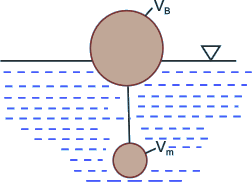|
Exercise Problems - Chapter 2
1. For the system shown in Fig 5.10,determine the air pressure pA which will make the pressure at N one fourth of that at M.
Fig 5.10
2. Consider the pipe and manometer system as shown in Fig 5.11. The pipe contains water. Find the value of manometer reading h, and the difference in pressure between A and B if there is no flow. If there is a flow from A towards B and the manometer reading is h = 60 mm, then determine the static pressure difference pA - pB
Fig 5.11
3. Determine the air pressure above the water surface in the tank if a force of 8 kN is required to hold the hinged door in position as shown in Fig 5.12.
Fig 5.12
4. The profile of the inner face of a dam takes the form of a parabola with the equation 18y = x2 , where y is the height above the base and x is the horizontal distance of the face from the vertical reference line. The water level is 27m above the base. Determine the thrust on the dam (per meter with) due to the water pressure, its inclination to the vertical and the point where the line of action of this force intersects the free water surface
| |
[ 5.28 MN/m, 42o 33', 30.29 m from face ] |
5. A solid uniform cylinder of length 150 mm and diameter 75 mm is to float upright in water. Determine the limits within which its mass should lie.
6. A long prism, the cross-section of which is an equilateral traingle of side a, floats in water with one side horizontal and submerged to a depth h. Find
(a) h/a as a function of the specific gravity, S of the prism.
(b) The metacentric height in terms of side a, for small angle of rotation if specific gravity, S=0.8.
7. A metal sphere of volume  , specific gravity , specific gravity  and fully immersed in water is attached by a flexible wire to a buoy of volume and fully immersed in water is attached by a flexible wire to a buoy of volume  and specific gravity and specific gravity  . Calculate the tension T in the wire and volume of the buoy that is submerged. Refer to Fig 5.13. . Calculate the tension T in the wire and volume of the buoy that is submerged. Refer to Fig 5.13.

Fig 5.13
To
view the recap, click next button or select from left-hand-side. |
|